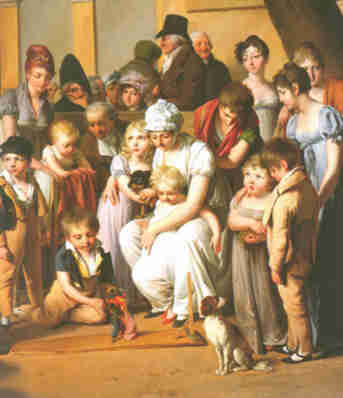 Figure 1.--This street scene painted by Boilly in 1812 show that boys were wearing skeleton suits with long trousers while men were still wearing knee breeches. |

|
French artist born at La Russee (1761) was one of the most prolific artists of all time. He is known for both his genre works and portraits. He was also a talented draftsman. He was much influenced by the Dutch genre painters. Notable among the incredible 5,000 paintaings and drawing credited to him is The Arrival of the Diligence (Louvre, 1803). Many of his paintings and real life scenes provide ifascinating glimpses of French boys' fashions of his time. He painted many well crafted portrait paintings. He is perhaps best known for a vast number of genre paintings which provide views of middle-class social life during the tumultous late-18th abnd early-19th century. His life and body of work spanned the Bourbon monarchical France, the French Revolution, the Napoleonic Empire, the Bourbon Restoration, as well as the July Monarchy. No other single artust has privided us wuth such a huge body if ork bringing gthese eras to life. We do not see the super-patriotic imges of David, but rather the ordinary day-to-day life of the French people while the great issus of the day were being resolved. And mixed in with the groups of people in his genre paintings are many children.
Louis' father was a local wood sculptor.
Boilly was born in La Bassée in northern France.
Coming from a modest bckgrond, Boilly was a self-taught artit. Although he did receive some instruction by established artists as a teenager ahd young man. Boilly was much influenced by the Dutch genre painters.
Boilly began his artitic career at a very young age, when othr boys of his class were beginning an apprenticeship, about 12-13 years of age. He began to show his work to the Austin friars of Douai (1774). They were apparently impressed. The bishop of Arras invited young Louis to work and study in his bishopric (1777). While with the Bishop, a steady stram of painyings began -- an estimated 300 small portraits. Dominique Doncre (1743–1820) worked wuith him on trompe l'oeil painting. He moved to Paris to continue his career just before the Revolutuiin (about 1787).
As was the case of many artrists, Boilly got in trouble during the Terrior. Artists at the time earned theur living by painting poertaits of the well-to-do, thus they had connctiins with the aristicracy, In addition their works could be sudied for clues as tio theur politics. Boilly was condemned by the Committee of Public Safety for the erotic undertones of his work (1794) We are not sure just what paintings they were looking at. We do not see erotic undertones in his works, t least the ones we have seen. Some of his earky genre works did deoict anorous scenes. Before he was executed, however, a dutifully patriotic work was found in his home -- The Triumph of Marat (Musée des Beaux Arts, Lille). We wonder if he painted it to varnish his revolutionry credentisls. It may have save hom from the guillotine.
His youngest son, Alphonse Boilly (1801–67), was a professional engraver who apprenticed in New York with Asher Brown Durand. We are not syre why he went to America as a boy.
Boilly was one of the most prolific artists of all time. Some 5,000 paintings and drawing are ascribed to him. He is known for both his genre works and portraits. He was also a talented draftsman. . Many of his paintings and real life scenes provide ifascinating glimpses of French boys' fashions of his time. He painted many well crafted portrait paintings. He is perhaps best known for a vast number of genre paintings which provide views of middle-class social life during the tumultous late-18th abnd early-19th century. His life and body of work spanned the Bourbon monarchical France, the French Revolution, the Napoleonic Empire, the Bourbon Restoration, as well as the July Monarchy. No other single artust has privided us wuth such a huge body if ork bringing these eras to life. We do not see the super-patriotic imges of David, but rather the ordinary day-to-day life of the French people while the great issus of the day were being resolved. And mixed in with the groups of people in his genre paintings are many children.
Boilly was a a regonized artist of considerable popularity of his time. He was awarded a medal by the Parisian Salon for his work 'The Arrival of a Mail-coach in the Courtyard of the Messageries' (1804). He was decorated as a chevalier of the nation's highest order, the Legion d'Honneu (1833).
Some of his paintings and real life scenes provide interesting glimpses of French boys' fashions of his time.
Boilly died in Paris (1845).
Navigate the Boys' Historical Clothing Artist pages:
[Return to the Main French artist page]
[Return to the Main artist page]
[Chronology][Countries][Individuals][Styles]
Navigate the Boys' Historical Clothing Web Site:
[Introduction][Activities][Biographies][Chronology][Clothing styles][Countries][Theatricals][Topics]
[Bibliographies][Contributions][FAQs][Glossaries][Images][Links][Registration][Tools]
[Boys' Clothing Home]
